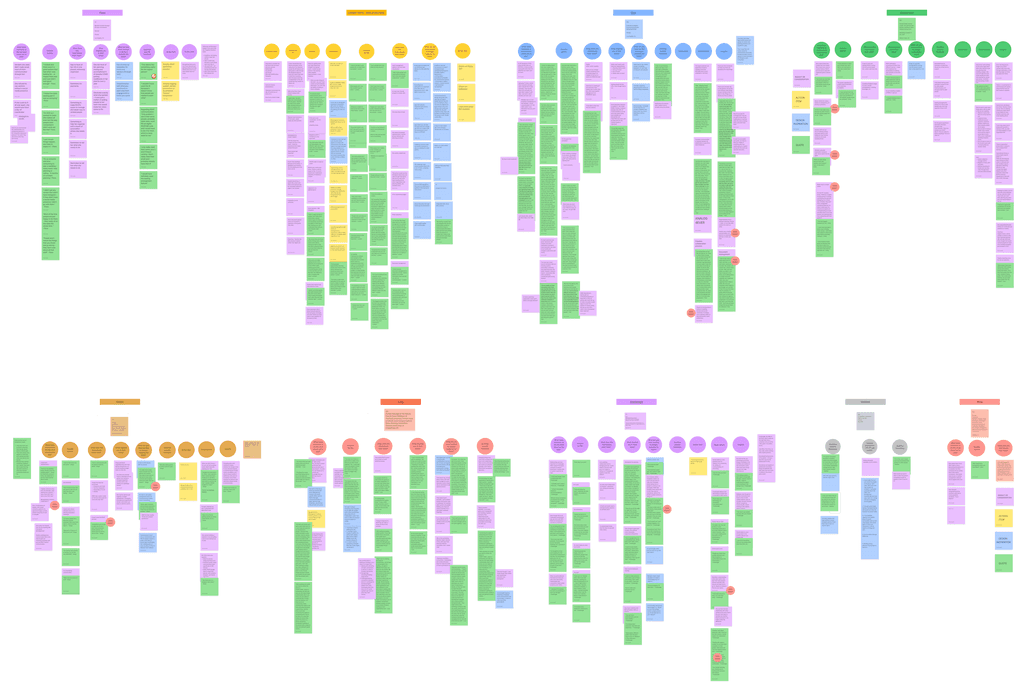.
A multi-device digital solution that allows users to design, visualize, and collaborate on event planning.
.
Team
Role
Duration
Tools
.
Event planners do not have an efficient way to manage guests
.
Intuitive multi-device platform to meet you where you are
.

.
Context

.
Defining product goals, crafting a roadmap, and conducting user interviews

🎉
🎉
🎉
.
We realized we were only treating a symptom of a bigger issue
After conducting over 20 hours of in-depth interviews, 3 major pain points of event planning were uncovered:
Layout/Seating Arrangements
Take time, thought, and no easy way to do them exists
Guest communication
Can be repetitive and can compound into hours of limited time
RSVP
Essential for most events yet difficult to manage
"Events are nothing without guests… they can make or break an event."

Loriann Serna
CEO of Wife of the Party
.
🕐 Time
💸
Money
💔 Relationships
💭
How might we create a solution that allows event planners to efficiently manage guests?
.
Research with a new focus on guest management
.
Who do you serve when event planning encompasses all demographics?
Lori
25 years old
Small Business Owner
"Instagram Party Planner"
ABOUT
New business owner who started making balloon arches and expanded her business into event coordination.
Maintain & grow client base
Add parties to their Instagram portfolio
Build overall business
Stay organized
Better time management
Clear communication with client and guests
Small budget
Moving parts are overwhelming
The smallest mistakes cost her time and money
MOTIVATIONS
GOALS
PAIN POINTS
.
Strategizing our approach
Guest Input
We went back and forth on whether we wanted to include guests in the planning process, as we thought this would improve their experience. However, we wanted to give planners the ultimate authority and having guests involved with planning would make the process more complicated.
Including vendors
By adding vendors, our app became even more technically complicated than it already was. For the MVP we wanted to prioritize features that did not include a third party.
Feature Graveyard 🪦
Main user flows:
How might we ensure that each guest is taken care of?
Spreadsheet import
Contact list import
Social media friends
Templates
Custom fields
One touch interactions
Drag and drop
Tagging feature
Automation
Reminders
Automated messaging
How might we cater to different events?
How might we make seating intuitive?
How might we increase response rates and keep them organized?
Create Event
Seating
RSVPs
Add Guests
Chatbot
Ideating potential features and usability considerations
EVENT CREATION



Templates
Drag & arrange tables
CHATBOT


Keeping guest effort minimal as possible
Answers will be recorded on their profile without event planner doing anything
RUN OF SHOW


Events that have passed will turn grey, active events are highlighted
Each event can expand to display more information
SEATING

Horizontal/
vertical scroll


Another touchpoint to get RSVPs
Multiple ways to view tables
Can export or print


GUESTLIST
Multiple methods of importing guest information
Drag guests to add them to that bucket, used for seating people who are in the same groups / have things in common
.


Event hosts manually enter tags
Drag guests to buckets, which AI will use to automate seating
AI Solution
Manual Solution
Letting go of desired features and adapting to constraints
.

GUESTLIST
Pivotal Design Decision
EVENT CREATION
RSVP
I went with a Google Doc style to see other collaborators. Users were concerned that too many unexpected changes would be overwhelming, so I decided to make the event planners confirm changes before they're implemented.
COLLABORATION
RUN OF SHOW
Users really liked having pertinent information directly accessible without having to leave the app. From our interviews, event planners mentioned that there was no solution on the market that was useful DURING the event - it was mostly used for pre-planning. The ROS provides this value.
.
Business Impact
ACQUISITION
ACTIVITY
RETENTION
REVENUE
.
.
Brand & Style Guide

.
If I Had More Time…
Build and iterate more often
Adhere to WCAG guidelines
Explore VR/AR and AI
💭
💭
💭
.
AI- Yi- Yi!
Designing for AI is a whole other battle. Most of the functionalities are aided by AI, and if I had more time for this project I would have explored more about the effects of AI algorithms in design. It also taught me that “The AI will do it” is not an acceptable excuse for design problems that don’t have an easy answer. There are clear ways to guide the user or design systems to achieve goals without AI.
Paper beats rock and scissors
The most efficient solution is usually analog: paper was our biggest competitor. From our interviews, most event planners preferred to write because it was the lowest learning curve, most cost effective, and customizable platform. We extensively studied the pros and cons of paper which informed most of our design decisions.
Treat the root cause, not the symptom
When there are many moving parts to a problem, getting to the root solves 90% of it: the moving part of the problem we first approached was visualizing seating arrangements, but after digging deeper we come to realize that it was just the symptoms of one of the three main issues of lack of communication, disorganization, and time consuming nature of party planning. Solving those root problems allowed us to effectively solve our initial problem.












